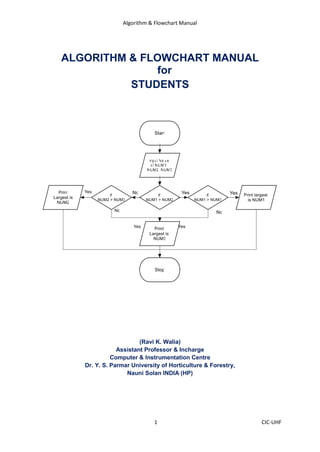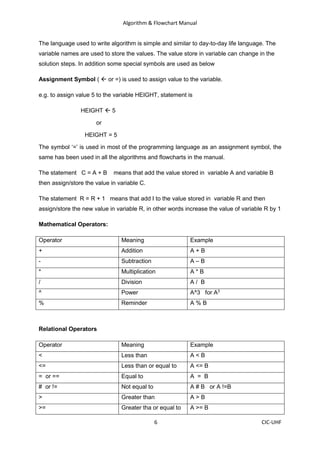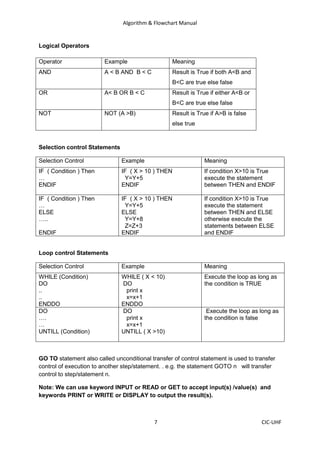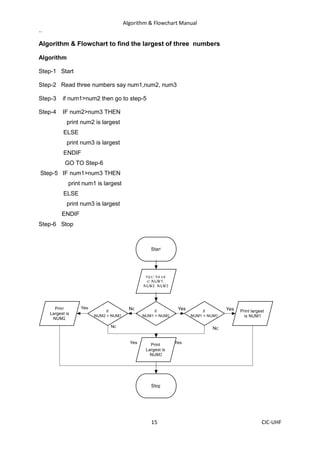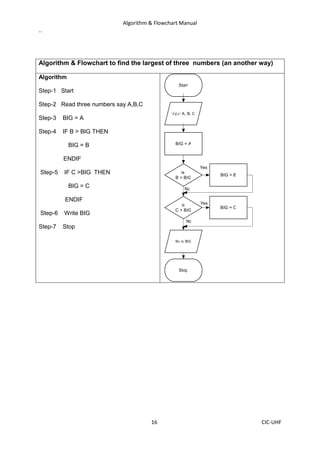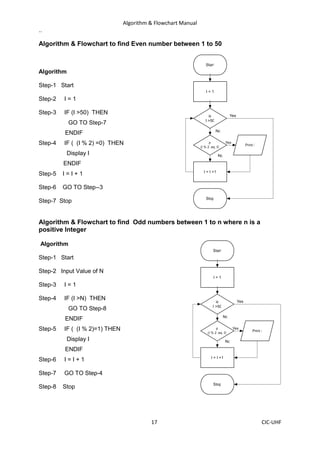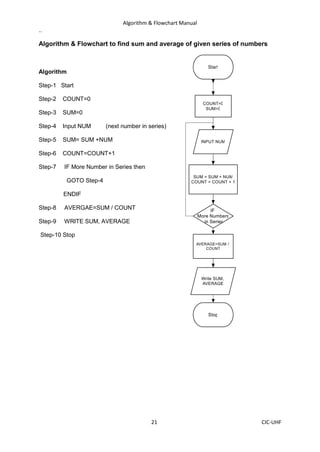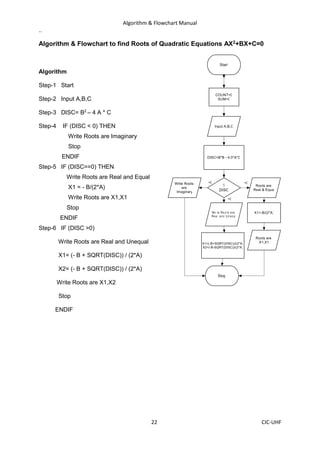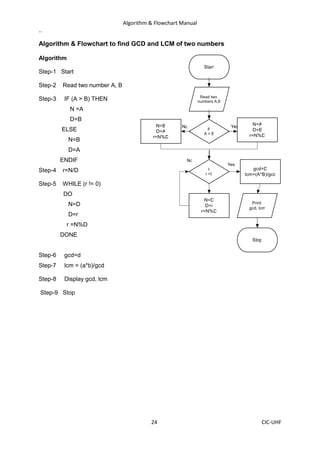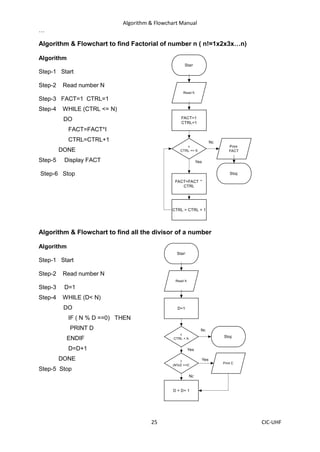Ad
detail of flowchart and algorithm that are used in programmingpdf
- 1. Algorithm & Flowchart Manual 1 CIC-UHF ALGORITHM & FLOWCHART MANUAL for STUDENTS (Ravi K. Walia) Assistant Professor & Incharge Computer & Instrumentation Centre Dr. Y. S. Parmar University of Horticulture & Forestry, Nauni Solan INDIA (HP)
- 2. Algorithm & Flowchart Manual 2 CIC-UHF PREFACE This document has been prepared for students at Dr. Y. S. Parmar University of Horticulture & Forestry, Nauni, Solan (HP) India. Software Engineer uses various programming languages to create programs. Before writing a program, first needs to find a procedure for solving the problem. The program written without proper pre-planning has higher chances of errors. Algorithm and flowchart are the powerful tools for learning programming. An algorithm is a step-by-step analysis of the process, while a flowchart explains the steps of a program in a graphical way. Algorithm and flowcharts helps to clarify all the steps for solving the problem. For beginners, it is always recommended to first write algorithm and draw flowchart for solving a problem and then only write the program. Beginners find it difficult to write algorithm and draw flowchart. The algorithm can vary from person to person to solve a particular problem. The manual will be useful for the students to learn algorithm and flowchart. It includes basics of algorithm and flowchart along with number of examples. Software ClickCharts by NCH (unlicensed version) has been used to draw all the flowcharts in the manual.
- 3. Algorithm & Flowchart Manual 3 CIC-UHF .. ALGORITHM: The word “algorithm” relates to the name of the mathematician Al-khowarizmi, which means a procedure or a technique. Software Engineer commonly uses an algorithm for planning and solving the problems. An algorithm is a sequence of steps to solve a particular problem or algorithm is an ordered set of unambiguous steps that produces a result and terminates in a finite time Algorithm has the following characteristics • Input: An algorithm may or may not require input • Output: Each algorithm is expected to produce at least one result • Definiteness: Each instruction must be clear and unambiguous. • Finiteness: If the instructions of an algorithm are executed, the algorithm should terminate after finite number of steps The algorithm and flowchart include following three types of control structures. 1. Sequence: In the sequence structure, statements are placed one after the other and the execution takes place starting from up to down. 2. Branching (Selection): In branch control, there is a condition and according to a condition, a decision of either TRUE or FALSE is achieved. In the case of TRUE, one of the two branches is explored; but in the case of FALSE condition, the other alternative is taken. Generally, the ‘IF-THEN’ is used to represent branch control. 3. Loop (Repetition): The Loop or Repetition allows a statement(s) to be executed repeatedly based on certain loop condition e.g. WHILE, FOR loops. Advantages of algorithm • It is a step-wise representation of a solution to a given problem, which makes it easy to understand. • An algorithm uses a definite procedure. • It is not dependent on any programming language, so it is easy to understand for anyone even without programming knowledge. • Every step in an algorithm has its own logical sequence so it is easy to debug.
- 4. Algorithm & Flowchart Manual 4 CIC-UHF HOW TO WRITE ALGORITHMS Step 1 Define your algorithms input: Many algorithms take in data to be processed, e.g. to calculate the area of rectangle input may be the rectangle height and rectangle width. Step 2 Define the variables: Algorithm's variables allow you to use it for more than one place. We can define two variables for rectangle height and rectangle width as HEIGHT and WIDTH (or H & W). We should use meaningful variable name e.g. instead of using H & W use HEIGHT and WIDTH as variable name. Step 3 Outline the algorithm's operations: Use input variable for computation purpose, e.g. to find area of rectangle multiply the HEIGHT and WIDTH variable and store the value in new variable (say) AREA. An algorithm's operations can take the form of multiple steps and even branch, depending on the value of the input variables. Step 4 Output the results of your algorithm's operations: In case of area of rectangle output will be the value stored in variable AREA. if the input variables described a rectangle with a HEIGHT of 2 and a WIDTH of 3, the algorithm would output the value of 6. FLOWCHART: The first design of flowchart goes back to 1945 which was designed by John Von Neumann. Unlike an algorithm, Flowchart uses different symbols to design a solution to a problem. It is another commonly used programming tool. By looking at a Flowchartone can understand the operations and sequence of operations performed in a system. Flowchart is often considered as a blueprint of a design used for solving a specific problem. Advantages of flowchart: • Flowchart is an excellent way of communicating the logic of a program. • Easy and efficient to analyze problem using flowchart. • During program development cycle, the flowchart plays the role of a blueprint, which makes program development process easier. • After successful development of a program, it needs continuous timely maintenance during the course of its operation. The flowchart makes program or system maintenance easier. • It is easy to convert the flowchart into any programming language code.
- 5. Algorithm & Flowchart Manual 5 CIC-UHF Flowchart is diagrammatic /Graphical representation of sequence of steps to solve a problem. To draw a flowchart following standard symbols are use Symbol Name Symbol function Oval Used to represent start and end of flowchart Parallelogram Used for input and output operation Rectangle Processing: Used for arithmetic operations and data-manipulations Diamond Decision making. Used to represent the operation in which there are two/three alternatives, true and false etc Arrows Flow line Used to indicate the flow of logic by connecting symbols Circle Page Connector Off Page Connector Predefined Process /Function Used to represent a group of statements performing one processing task. Preprocessor |-------------- --------- | |-------------- Comments
- 6. Algorithm & Flowchart Manual 6 CIC-UHF The language used to write algorithm is simple and similar to day-to-day life language. The variable names are used to store the values. The value store in variable can change in the solution steps. In addition some special symbols are used as below Assignment Symbol ( or =) is used to assign value to the variable. e.g. to assign value 5 to the variable HEIGHT, statement is HEIGHT 5 or HEIGHT = 5 The symbol ‘=’ is used in most of the programming language as an assignment symbol, the same has been used in all the algorithms and flowcharts in the manual. The statement C = A + B means that add the value stored in variable A and variable B then assign/store the value in variable C. The statement R = R + 1 means that add I to the value stored in variable R and then assign/store the new value in variable R, in other words increase the value of variable R by 1 Mathematical Operators: Operator Meaning Example + Addition A + B - Subtraction A – B * Multiplication A * B / Division A / B ^ Power A^3 for A3 % Reminder A % B Relational Operators Operator Meaning Example < Less than A < B <= Less than or equal to A <= B = or == Equal to A = B # or != Not equal to A # B or A !=B > Greater than A > B >= Greater tha or equal to A >= B
- 7. Algorithm & Flowchart Manual 7 CIC-UHF Logical Operators Operator Example Meaning AND A < B AND B < C Result is True if both A<B and B<C are true else false OR A< B OR B < C Result is True if either A<B or B<C are true else false NOT NOT (A >B) Result is True if A>B is false else true Selection control Statements Selection Control Example Meaning IF ( Condition ) Then … ENDIF IF ( X > 10 ) THEN Y=Y+5 ENDIF If condition X>10 is True execute the statement between THEN and ENDIF IF ( Condition ) Then … ELSE ….. ENDIF IF ( X > 10 ) THEN Y=Y+5 ELSE Y=Y+8 Z=Z+3 ENDIF If condition X>10 is True execute the statement between THEN and ELSE otherwise execute the statements between ELSE and ENDIF Loop control Statements Selection Control Example Meaning WHILE (Condition) DO .. .. ENDDO WHILE ( X < 10) DO print x x=x+1 ENDDO Execute the loop as long as the condition is TRUE DO …. … UNTILL (Condition) DO print x x=x+1 UNTILL ( X >10) Execute the loop as long as the condition is false GO TO statement also called unconditional transfer of control statement is used to transfer control of execution to another step/statement. . e.g. the statement GOTO n will transfer control to step/statement n. Note: We can use keyword INPUT or READ or GET to accept input(s) /value(s) and keywords PRINT or WRITE or DISPLAY to output the result(s).
- 8. Algorithm & Flowchart Manual 8 CIC-UHF .. Algorithm & Flowchart to find the sum of two numbers Algorithm Step-1 Start Step-2 Input first numbers say A Step-3 Input second number say B Step-4 SUM = A + B Step-5 Display SUM Step-6 Stop OR Algorithm Step-1 Start Step-2 Input two numbers say A & B Step-3 SUM = A + B Step-4 Display SUM Step-5 Stop
- 9. Algorithm & Flowchart Manual 9 CIC-UHF .. Algorithm & Flowchart to convert temperature from Celsius to Fahrenheit C : temperature in Celsius F : temperature Fahrenheit Algorithm Step-1 Start Step-2 Input temperature in Celsius say C Step-3 F = (9.0/5.0 x C) + 32 Step-4 Display Temperature in Fahrenheit F Step-5 Stop Algorithm & Flowchart to convert temperature from Fahrenheit to Celsius C : temperature in Celsius F : temperature Fahrenheit Algorithm Step-1 Start Step-2 Input temperature in Fahrenheit say F Step-3 C = 5.0/9.0 (F - 32 ) Step-4 Display Temperature in Celsius C Step-5 Stop
- 10. Algorithm & Flowchart Manual 10 CIC-UHF .. Algorithm & Flowchart to find Area and Perimeter of Square L : Side Length of Square AREA : Area of Square PERIMETER : Perimeter of Square Algorithm Step-1 Start Step-2 Input Side Length of Square say L Step-3 Area = L x L Step-4 PERIMETER = 4 x L Step-5 Display AREA, PERIMETER Step-6 Stop Algorithm & Flowchart to find Area and Perimeter of Rectangle L : Length of Rectangle B : Breadth of Rectangle AREA : Area of Rectangle PERIMETER : Perimeter of Rectangle Algorithm Step-1 Start Step-2 Input Side Length & Breadth say L, B Step-3 Area = L x B Step-4 PERIMETER = 2 x ( L + B) Step-5 Display AREA, PERIMETER Step-6 Stop
- 11. Algorithm & Flowchart Manual 11 CIC-UHF .. Algorithm & Flowchart to find Area and Perimeter of Circle R : Radius of Circle AREA : Area of Circle PERIMETER : Perimeter of Circle Algorithm Step-1 Start Step-2 Input Radius of Circle say R Step-3 Area = 22.0/7.0 x R x R Step-4 PERIMETER = 2 x 22.0/7.0 x R Step-5 Display AREA, PERIMETER Step-6 Stop Algorithm & Flowchart to find Area & Perimeter of Triangle (when three sides are given) A : First Side of Triangle B : Second Side of Triangle C : Third Side of Triangle AREA : Area of Triangle PERIMETER : Perimeter of Triangle Algorithm Step-1 Start Step-2 Input Sides of Triangle A,B,C Step-3 S= (A + B + C)/ 2.0 Step-4 AREA = SQRT(S x (S-A) x (S-B) x(S-C)) Step-5 PERIMETER = S1 + S2 + S3 Step-6 Display AREA, PERIMETER Step-7 Stop Start Input Value of R AREA = 22.0/7.0 x R x R Print AREA, PERIMTER Stop PERIMTER = 2 X 22.0/7.0 x R
- 12. Algorithm & Flowchart Manual 12 CIC-UHF .. .. Algorithm & Flowchart to find Simple Interest P : Principle Amount N : Time in Years R : % Annual Rate of Interest SI : Simple Interest Algorithm Step-1 Start Step-2 Input value of P, N, R Step-3 SI = (P x N x R)/100.0 Step-4 Display SI F Step-6 Stop Algorithm & Flowchart to find Compound Interest P : Principle Amount N : Time in Years R : % Annual Rate of Interest CI : Compound Interest Algorithm Step-1 Start Step-2 Input value of P, N, R C Step-3 CI = P(1+R/100)N - P Step-4 Display CI Step-6 Stop
- 13. Algorithm & Flowchart Manual 13 CIC-UHF .. Algorithm & Flowchart to Swap Two Numbers using Temporary Variable Algorithm Step-1 Start Step-2 Input Two Numbers Say NUM1,NUM2 Step-3 Display Before Swap Values NUM1, NUM2 Step-4 TEMP = NUM1 Step-5 NUM1 = NUM2 Step-6 NUM2 = NUM1 Step-7 Display After Swap Values NUM1,NUM Step-8 Stop Algorithm & Flowchart to Swap Two Numbers without using temporary variable Algorithm Step-1 Start Step-2 Input Two Numbers Say A,B Step-3 Display Before Swap Values A, B Step-4 A = A + B Step-5 B = A - B Step-6 A = A - B Step-7 Display After Swap Values A, B Step-8 Stop temp
- 14. Algorithm & Flowchart Manual 14 CIC-UHF .. Algorithm & Flowchart to find the smallest of two numbers Algorithm Step-1 Start Step-2 Input two numbers say NUM1,NUM2 Step-3 IF NUM1 < NUM2 THEN print smallest is NUM1 ELSE print smallest is NUM2 ENDIF Step-4 Stop Algorithm & Flowchart to find the largest of two numbers Algorithm Step-1 Start Step-2 Input two numbers say NUM1,NUM2 Step-3 IF NUM1 > NUM2 THEN print largest is NUM1 ELSE print largest is NUM2 ENDIF Step-4 Stop Start Input Value of NUM1 Input Value of NUM2 Stop if NUM1 > NUM2 Print Largest is NUM2 Print Largest is NUM1 Yes No
- 15. Algorithm & Flowchart Manual 15 CIC-UHF .. Algorithm & Flowchart to find the largest of three numbers Algorithm Step-1 Start Step-2 Read three numbers say num1,num2, num3 Step-3 if num1>num2 then go to step-5 Step-4 IF num2>num3 THEN print num2 is largest ELSE print num3 is largest ENDIF GO TO Step-6 Step-5 IF num1>num3 THEN print num1 is largest ELSE print num3 is largest ENDIF Step-6 Stop
- 16. Algorithm & Flowchart Manual 16 CIC-UHF .. Algorithm & Flowchart to find the largest of three numbers (an another way) Algorithm Step-1 Start Step-2 Read three numbers say A,B,C Step-3 BIG = A Step-4 IF B > BIG THEN BIG = B ENDIF Step-5 IF C >BIG THEN BIG = C ENDIF Step-6 Write BIG Step-7 Stop
- 17. Algorithm & Flowchart Manual 17 CIC-UHF .. Algorithm & Flowchart to find Even number between 1 to 50 Algorithm Step-1 Start Step-2 I = 1 Step-3 IF (I >50) THEN GO TO Step-7 ENDIF Step-4 IF ( (I % 2) =0) THEN Display I ENDIF Step-5 I = I + 1 Step-6 GO TO Step--3 Step-7 Stop Algorithm & Flowchart to find Odd numbers between 1 to n where n is a positive Integer Algorithm Step-1 Start Step-2 Input Value of N Step-3 I = 1 Step-4 IF (I >N) THEN GO TO Step-8 ENDIF Step-5 IF ( (I % 2)=1) THEN Display I ENDIF Step-6 I = I + 1 Step-7 GO TO Step-4 Step-8 Stop
- 18. Algorithm & Flowchart Manual 18 CIC-UHF .. Algorithm & Flowchart to find sum of series 1+2+3+…..+N Algorithm Step-1 Start Step-2 Input Value of N Step-3 I = 1, SUM=0 Step-4 IF (I >N) THEN GO TO Step-8 ENDIF Step-5 SUM = SUM + I Step-6 I = I + 1 Step-7 Go to step-4 Step-8 Display value of SUM Step-9 Stop Algorithm & Flowchart to find sum of series 1+3+5+…..+N, Where N is positive odd Integer Algorithm Algorithm Step-1 Start Step-2 Input Value of N Step-3 I = 1, SUM=0 Step-4 IF (I >N) THEN GO TO step 8 ENDIF Step-5 SUM = SUM + I Step-6 I = I + 2 Step-7 Go to step-4 Step-8 Display value of SUM Step-9 Stop
- 19. Algorithm & Flowchart Manual 19 CIC-UHF .. Algorithm & Flowchart to find sum of series 1 – X + X2 –X3 ….XN Algorithm Step-1 Start Step-2 Input Value of N, X Step-3 I = 1, SUM=1, TERM=1 Step-4 IF (I >N) THEN GO TO Step-9 ENDIF Step-5 TERM = - TERM * X Step-6 SUM = SUM + TERM Step-7 I = I + 1 Step-8 Go to step-4 Step-9 Display value of SUM Step-10 Stop Algorithm & Flowchart to print multiplication Table of a number Algorithm Step-1 Start Step-2 Input Value of NUM Step-3 I = 1 Step-4 IF (I >10) THEN GO TO Step 9 ENDIF Step-5 PROD = NUM * I Step-6 WRITE I “x” NUM “=” PROD Step-7 I = I + 1 Step-8 Go to step-4 Step-9 Stop
- 20. Algorithm & Flowchart Manual 20 CIC-UHF .. Algorithm & Flowchart to generate first n Fibonacci terms 0,1,1,2,3,5…n (n>2) Algorithm Step-1 Start Step-2 Input Value of N Step-3 A=0, B=1, COUNT=2 Step-4 WRITE A, B Step-5 IF (COUNT >N) then go to step 12 Step-6 NEXT= A + B Step-7 WRITE NEXT Step-8 A=B Step-9 B=NEXT Step-10 COUNT=COUNT + 1 Step-11 Go to step-4 Step-12 Stop
- 21. Algorithm & Flowchart Manual 21 CIC-UHF .. Algorithm & Flowchart to find sum and average of given series of numbers Algorithm Step-1 Start Step-2 COUNT=0 Step-3 SUM=0 Step-4 Input NUM (next number in series) Step-5 SUM= SUM +NUM Step-6 COUNT=COUNT+1 Step-7 IF More Number in Series then GOTO Step-4 ENDIF Step-8 AVERGAE=SUM / COUNT Step-9 WRITE SUM, AVERAGE Step-10 Stop
- 22. Algorithm & Flowchart Manual 22 CIC-UHF .. Algorithm & Flowchart to find Roots of Quadratic Equations AX2+BX+C=0 Algorithm Step-1 Start Step-2 Input A,B,C Step-3 DISC= B2 – 4 A * C Step-4 IF (DISC < 0) THEN Write Roots are Imaginary Stop ENDIF Step-5 IF (DISC==0) THEN Write Roots are Real and Equal X1 = - B/(2*A) Write Roots are X1,X1 Stop ENDIF Step-6 IF (DISC >0) Write Roots are Real and Unequal X1= (- B + SQRT(DISC)) / (2*A) X2= (- B + SQRT(DISC)) / (2*A) Write Roots are X1,X2 Stop ENDIF
- 23. Algorithm & Flowchart Manual 23 CIC-UHF .. Algorithm & Flowchart to find if a number is prime or not Algorithm Step-1 Start Step-2 Input NUM Step-3 R=SQRT(NUM) Step-4 I=2 Step-5 IF ( I > R) THEN Write NUM is Prime Number Stop ENDIF Step 6 IF ( NUM % I ==0) THEN Write NUM is Not Prime Stop ENDIF Step-7 I = I + 1 Step-8 Go to Step-5
- 24. Algorithm & Flowchart Manual 24 CIC-UHF .. Algorithm & Flowchart to find GCD and LCM of two numbers Algorithm Step-1 Start Step-2 Read two number A, B Step-3 IF (A > B) THEN N =A D=B ELSE N=B D=A ENDIF Step-4 r=N/D Step-5 WHILE (r != 0) DO N=D D=r r =N%D DONE Step-6 gcd=d Step-7 lcm = (a*b)/gcd Step-8 Display gcd, lcm Step-9 Stop
- 25. Algorithm & Flowchart Manual 25 CIC-UHF … Algorithm & Flowchart to find Factorial of number n ( n!=1x2x3x…n) Algorithm Step-1 Start Step-2 Read number N Step-3 FACT=1 CTRL=1 Step-4 WHILE (CTRL <= N) DO FACT=FACT*I CTRL=CTRL+1 DONE Step-5 Display FACT Step-6 Stop Algorithm & Flowchart to find all the divisor of a number Algorithm Step-1 Start Step-2 Read number N Step-3 D=1 Step-4 WHILE (D< N) DO IF ( N % D ==0) THEN PRINT D ENDIF D=D+1 DONE Step-5 Stop
